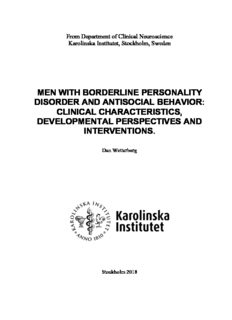
men with borderline personality disorder and antisocial behavior PDF
Preview men with borderline personality disorder and antisocial behavior
From Department of Clinical Neuroscience Karolinska Institutet, Stockholm, Sweden MEN WITH BORDERLINE PERSONALITY DISORDER AND ANTISOCIAL BEHAVIOR: CLINICAL CHARACTERISTICS, DEVELOPMENTAL PERSPECTIVES AND INTERVENTIONS. Dan Wetterborg Stockholm 2018 All previously published papers were reproduced with permission from the publisher. Published by Karolinska Institutet. Printed by Eprint AB © Dan Wetterborg, 2018 ISBN 978-91-7831-120-0 Men with borderline personality disorder and antisocial behavior: clinical characteristics, developmental perspectives and interventions. THESIS FOR DOCTORAL DEGREE (Ph.D.) By Dan Wetterborg Principal Supervisor: Opponent: Associate professor Pia Enebrink Professor Ueli Kramer Karolinska Institutet University of Lausanne Department of Clinical Neuroscience Institute of Psychotherapy and General Psychiatry Division of Psychology Department of Psychiatry Co-supervisor(s): Examination Board: Professor Gerhard Andersson Professor Agneta Öjehagen Linköping University Lund University Department of Behavioral Sciences and Learning Department of Clinical Sciences Division of Psychiatry Professor Alan Fruzzetti Harvard Medical School Associate professor Richard Bränström McLean Hospital and Department of Psychiatry Karolinska Institutet Department of Clinical Neuroscience Division of Psychology Associate professor Daiva Daukantaité Lund University Department of Psychology To Louise, Adam, Simon and Lukas. ABSTRACT Background: Borderline personality disorder (BPD) is a mental disorder characterized by a pervasive pattern of emotional instability, impulsivity, relationship problems and identity disturbance. As the disorder has been considered more prevalent in women, research on men with BPD has lagged behind. In addition to the suicidal and self-harming behaviors traditionally associated with BPD, a substantial proportion of men with this disorder also exhibit antisocial behaviors. Aims: • to estimate the prevalence of BPD in a sample of adult male offenders on probation or parole in Stockholm, and examine comorbidity patterns (Study I). • to explore how men with BPD and antisocial behaviors describe their difficulties and their experiences of the health care system (Study II). • to investige the utility of 12 months treatment with Dialectical behavior therapy (DBT) for men with BPD and antisocial behavior (Study III). • to evaluate a new internet-delivered preventive program for parents of adolescents at risk of developing BPD-traits and/or antisocal behavior (Study IV). Methods: We screened 109 probationers for BPD and conducted diagnostic interviews with those scoring above cut-off (Study I). We interviewed 8 men and analyzed the data using qualitative content analysis (Study II). Thirty men received DBT in a study using within-group design with repeated measurements of various dysfunctional behaviors (Study III). We randomized parents to receive the Parent-Web intervention directly (n= 43) or to a waitlist control (n= 32), and compared the groups on adolescent externalizing behavior, family conflicts and warmth (Study IV). Results: 19.8% of male offenders on probation were estimated to have BPD, and the disorder was associated with severe mental ill health. Male psychiatric patients with BPD and antisocial behavior experienced a distressing sense of alienation and had experienced difficulties accessing mental health resources. After DBT, participants had reduced most of the dysfunctional behaviors assessed. Treatment completers (n= 19) reported high satisfaction with treatment, and maintained their improvements one year after the intervention. The Parent-Web was associated with interrupted deterioration of adolescent externalizing behavior and improvements in conflicts and family warmth. Conclusions: BPD may be 10-times more common in male probationers/parolees than in the general population. Although men with BPD and antisocial behavior may have difficulties utilizing mental health services, preliminary evidence suggest that DBT may be a treatment alternative worth considering. A short internet delivered program may reduce risk factors associated with the development of BPD and antisocial behavior in adolescents. LIST OF SCIENTIFIC PAPERS I. Wetterborg, D., Långström, N., Andersson, G., & Enebrink, P. (2015). Borderline Personality Disorder: Prevalence and psychiatric comorbidity among male offenders on probation in Sweden. Comprehensive Psychiatry, 62: 63-70. II. Wetterborg, D., Andersson, G., & Enebrink, P. (submitted manuscript). Exploring Borderline Personality Disorder in men with comorbid antisocial behavior: A qualitative interview study. III. Wetterborg, D., Dehlbom, P., Långström, N., Andersson, G., Fruzzetti, A., & Enebrink, P. (in press). Dialectical Behavior Therapy for men with Borderline Personality Disorder and antisocial behavior: A clinical trial. Journal of Personality Disorders. IV. Wetterborg, D., Enebrink, P., Lönn-Rhodin, K., Forster, M., Risto, E., Dahlström, J., Forsberg, K., & Ghaderi, A. (submitted manuscript). A Randomized Controlled Trial of Internet-delivered Parent Training for parents of teenagers. CONTENTS 1 Introduction ............................................................................................................ 1 2 Background ............................................................................................................ 3 2.1 Borderline personality disorder ............................................................................. 3 2.1.2 Diagnosis ................................................................................................. 3 2.1.2 Prevalence, comorbidity and functional impairment ................................... 4 2.1.3 Treatment ................................................................................................. 4 2.2 Men with borderline personality disorder ........................................................... 5 2.2.1 Gender and the BPD diagnosis .................................................................. 6 2.2.2 Similarities and differences across gender ................................................. 7 2.3 Antisocial personality disorder in BPD .............................................................. 7 2.3.1 Development ............................................................................................ 9 2.3.2 Early prevention ..................................................................................... 11 2.3.3 Treatment of men with BPD ................................................................... 12 2.4 Summary of background ................................................................................. 14 3 Aims .................................................................................................................... 15 3.1 Overall aims of the thesis ................................................................................ 15 3.1.1 Study I ................................................................................................... 15 3.1.2 Study II .................................................................................................. 15 3.1.3 Study III ................................................................................................. 15 3.1.4 Study IV ................................................................................................. 15 4 Summary of studies .............................................................................................. 17 4.1 Study I ............................................................................................................ 17 4.2 Study II........................................................................................................... 18 4.3 Study III ......................................................................................................... 18 4.4 Study IV ......................................................................................................... 21 4.4 Ethical considerations ..................................................................................... 22 5 Discussion ............................................................................................................ 24 5.1 Main findings, strenghts and limitations ........................................................... 24 5.1.1 StudyI .................................................................................................... 24 5.1.2 Study II .................................................................................................. 25 5.1.3 Study III ................................................................................................. 25 5.1.4 Study IV ................................................................................................. 26 5.2 Characteristics of the samples .......................................................................... 27 5.2.1 the BPD-samples .................................................................................... 27 5.2.4 The parent-sample .................................................................................. 29 5.3 Implications for researchers and clincians ........................................................ 30 5.4 Conclusions .................................................................................................... 34 6 Svensk sammanfattning ........................................................................................ 35 7 Aknowledgements ................................................................................................ 36 8 References ............................................................................................................ 38
Description: